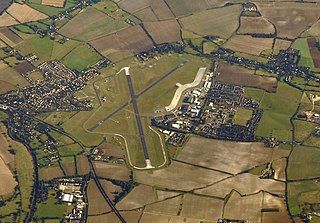
Royal Air Force Benson or RAF Benson is a Royal Air Force (RAF) station located at Benson, near Wallingford, in South Oxfordshire, England. It is a front-line station and home to the RAF's fleet of Westland Puma HC2 support helicopters, used primarily for the transportation of troops & equipment. Flying squadrons comprise No. 33 Squadron flying the Puma, No. 22 Squadron which provides operational evaluation and training for all aircraft in Joint Helicopter Command and No. 28 Squadron, which is the combined Puma and Boeing Chinook HC6A training unit. Other units include the Oxford University Air Squadron and No. 6 Air Experience Flight, both flying the Grob Tutor T1 light training aircraft used for student and cadet flying training. The National Police Air Service and the Thames Valley Air Ambulance are also based at the station, both operating Airbus H135 helicopters.

Royal Air Force Digby otherwise known as RAF Digby is a Royal Air Force station located near Scopwick and 11.6 mi (18.7 km) south east of Lincoln, in Lincolnshire, England. The station is home to the tri-service Joint Service Signals Organisation, part of the Joint Forces Intelligence Group of Joint Forces Command. Other units include the RAF Aerial Erector School, No. 54 Signals Unit and No. 591 Signals Unit.

The Central Flying School (CFS) is the Royal Air Force's primary institution for the training of military flying instructors. Established in 1912 at the Upavon Aerodrome, it is the longest existing flying training school. The school was based at RAF Little Rissington from 1946 to 1976. Its motto is Imprimis Praecepta, Latin for "The Teaching is Everlasting".
Royal Air Force Montrose or more simply RAF Montrose is a former Royal Air Force station in Forfarshire in Scotland. It became the first operational military aerodrome to be established in the United Kingdom on 26 February 1913.

Hawarden Airport, is an airport near Hawarden in Flintshire, Wales, near the border with England and 3.5 NM west southwest of the city of Chester.
The Royal Air Force Volunteer Reserve (RAFVR) was established in 1936 to support the preparedness of the U.K. Royal Air Force in the event of another war. The Air Ministry intended it to form a supplement to the Royal Auxiliary Air Force (RAuxAF), the active reserve for the RAF, by providing an additional non-active reserve. However during the Second World War the high demand for aircrew absorbed all available RAuxAF personnel and led the RAFVR to quickly become the main pathway of aircrew entry into the RAF. It was initially composed of civilians recruited from neighbourhood reserve flying schools, run by civilian contractors with largely RAF-trained flying instructors as well as other instructors in related air war functions, such as observers and wireless operators.

727 Naval Air Squadron is a squadron of the Royal Navy Fleet Air Arm. It was formed in 1943 as a Fleet Requirements Unit, being disbanded in December 1944. It was reformed twice in the 1940s and 1950s to provide flying experience for naval officers. The current squadron was created on 6 Dec 2001 from the Royal Naval Flying Training Flight. It operates the Grob Tutor, with its primary role to provide grading and legacy-Elementary Flying Training for Royal Navy and Royal Marine pilots under training. It also supports the Royal Navy's "Flying Start" flying scholarship scheme.

Air Marshal Sir Harold Brownlow Morgan "Micky" Martin, was an Australian bomber pilot and senior commander in the Royal Air Force (RAF). He took part in Operation Chastise, the RAF's "Dambusters" raid in 1943, and was described by journalist Sir Max Hastings as "one of the three great bomber pilots of the war". He rose to become a senior officer in the RAF, commanding RAF Germany and later serving as Air Member for Personnel, a member of the Air Council, the RAF's controlling body.
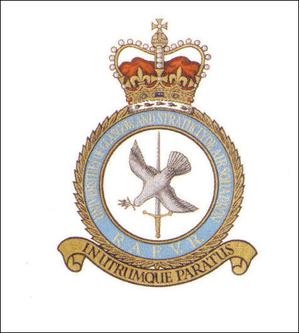
A Royal Air Force University Air Squadron recruiting within Scotland, Universities of Glasgow and Strathclyde Air Squadron draws its members from six higher education establishments within Glasgow and its surrounding areas.
Air Commodore Cathcart Michael Wight-Boycott, was a British fighter pilot during the Second World War and a senior Royal Air Force officer during the post-war years. In 1961, Wight-Boycott became the 10th Commandant Royal Observer Corps.
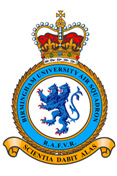
The University of Birmingham Air Squadron, commonly known as UBAS, is a squadron within the Royal Air Force established on 3 May 1941. It is based at RAF Cosford, Shropshire, and flies a fleet of six Grob Tutors. In 2009 the squadron upgraded the aircraft to the Grob Tutor EA which has an advanced avionics suite. The Squadron has three Flights, A, B and C; each with a student Flight Commander who holds the rank of Acting Pilot Officer. UBAS is also the parent squadron of 8 Air Experience Flight, who jointly fly UBAS' Tutor fleet.

The Oxford University Air Squadron, abbreviated Oxford UAS, or OUAS, formed in 1925, is the training unit of the Royal Air Force at the University of Oxford and forms part of the Royal Air Force Volunteer Reserve. OUAS is one of fifteen University Air Squadrons that are spread out across Great Britain and it recruits from the universities at Oxford and Reading University.
Wing Commander Edward Chatham Wolfe was a famed World War II Royal Air Force fighter pilot who flew during the Battle of Britain.

Air Marshal Sir Patrick Hunter Dunn, was a Scottish Royal Air Force officer who served as Air Officer Commanding-in-Chief of Flying Training Command from 1964 to 1966.
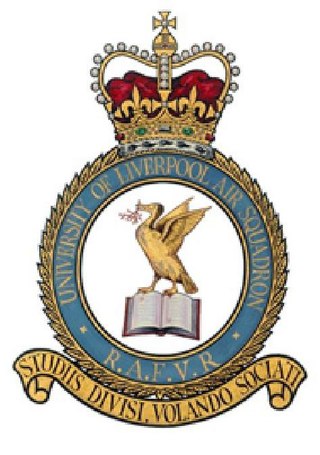
Liverpool University Air Squadron is a training unit of the Royal Air Force which provides basic flying training, adventurous training and personal development skills to undergraduate students of the University of Liverpool, University of Lancaster, Edge Hill University, Bangor University and Liverpool John Moores University.
Northumbrian Universities Air Squadron is a unit of the Royal Air Force which provides basic flying training, adventurous training and personal development skills to undergraduate students of the University of Durham, University of Newcastle upon Tyne, Northumbria University, Sunderland University and Teesside University. The idea behind all University Air Squadrons is to allow potential RAF officers to experience life in service and to allow them to decide whether they are suited to it. There is no obligation to join up, unless a bursary is successfully applied for. NUAS is parented by RAF Leeming where it flies Grob Tutor aircraft. NUAS Town Headquarters (THQ) are in Newcastle upon Tyne.
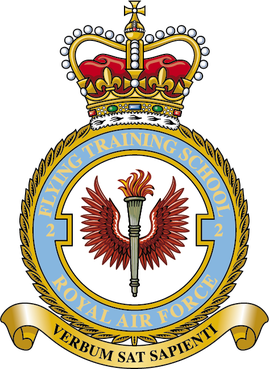
No.2 Flying Training School is a Flying Training School (FTS) of the Royal Air Force (RAF). It is part of No. 22 (Training) Group that delivers glider flying training to the Royal Air Force Air Cadets. Its headquarters is located at RAF Syerston in Nottinghamshire and gliding takes places from several sites throughout the UK using the Grob Viking T1. The RAF Central Gliding School is also under its command.
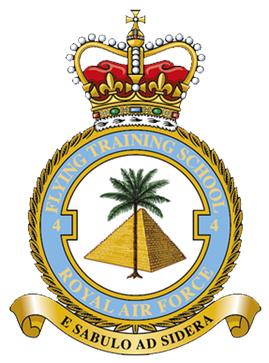
No. 4 Flying Training School is a Royal Air Force military flying training school, which manages Advanced Fast Jet Training (AFJT) from its base at RAF Valley in Anglesey, Wales. Its role is to provide fast jet aircrew to the Operational Conversion Units for the RAF's jet attack aircraft, the Eurofighter Typhoon and the Lockheed Martin F-35 Lightning II.

Thomas Welch Horton, was a Royal New Zealand Air Force (RNZAF) officer, pilot, and combat veteran who served with the Royal Air Force (RAF) in a number of significant engagements during the Second World War. He was a member of No. 88 Squadron and flew anti-ship missions in the Bristol Blenheim and Douglas Boston. Horton also served with and later commanded No. 105 Squadron flying the de Havilland Mosquito in the Pathfinder Force (PFF) that marked targets for destruction by following groups of heavy bombers.
No. 2 Squadron was a Royal Canadian Air Force (RCAF) squadron active during the late 1930s. The squadron operated army cooperation aircraft from 1935, and upon the outbreak of World War II was selected for overseas duty. However, a shortage of aircraft forced its disbandment in late 1939 to reinforce two other squadrons.
















